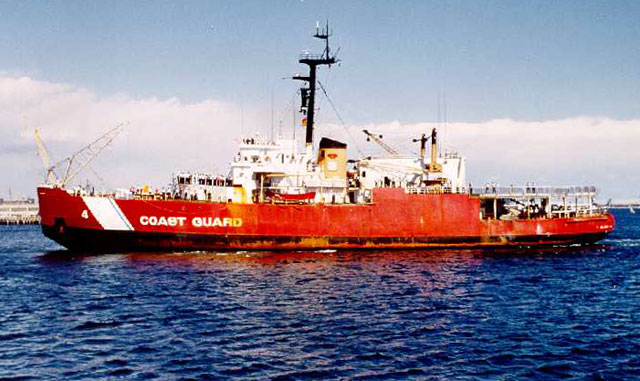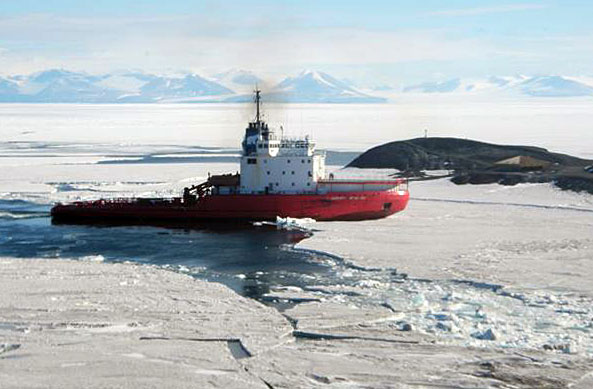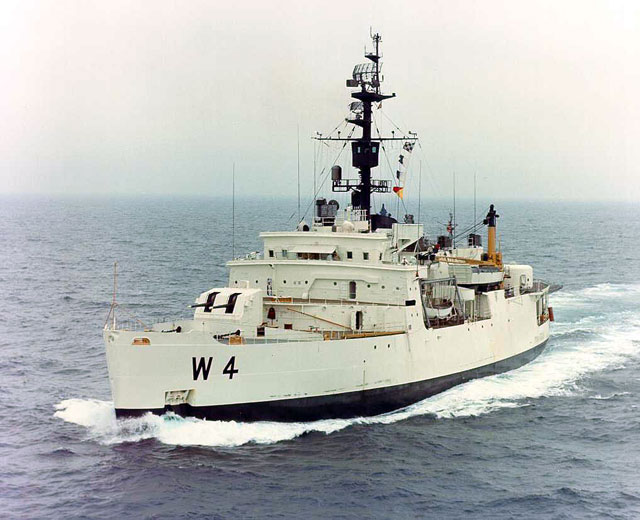Breaking pointEfforts to save historic Glacier fall short amid tough times for icebreaking fleetPosted July 27, 2012
It’s been tough times for U.S. icebreakers in recent years. Efforts to save perhaps the most historic of the nation’s ice-breaking vessels ended in the scrap yard earlier this month. Meanwhile, one of the two remaining U.S. Coast Guard’s The flagship of famous polar explorer Adm. Richard E. Byrd during its maiden voyage to Antarctica, the U.S. ship (USS) Glacier was commissioned in 1955. It was reputedly the most powerful icebreaker of its era, capable of busting through 20 feet of ice. The Glacier’s first trip south in 1955-56 was part of the U.S. Navy’s Operation Deep Freeze The ship served in the Navy for about 11 years, before the icebreaker fleet was turned over to the U.S. Coast Guard in 1966. The U.S. Coast Guard cutter (USCGC) Glacier would continue to operate until 1987, even after the Polar-class icebreakers USCGC Polar Star and USCGC Polar Sea 
Photo Credit: U.S. Navy
The GLACIER. In the mid-1970s, the Coast Guard began painting all of its polar icebreakers' hulls red to make them easier for helicopter pilots to spot in the ice.
The Glacier was more than just an ice-ramming machine during its tenure, as it also participated in expeditions of exploration and research. For instance, while aboard the Glacier, scientist James Van Allen of the University of Iowa Its storied history led to the formation in 1998 of the nonprofit Glacier Society “We are deeply saddened by the Glacier loss, but I am reminded of the words of Col. Norman Vaughn: ‘Dream big and dare to fail!’” wrote Glacier Society Chairman Ben Koether on the organization’s website after a last-bid plea to forestall the ship’s “execution” failed. MARAD has reportedly offered the Glacier Society a substitute ship, but Koether said in an email to The Antarctic Sun that there are many details to work out — and apparently not enough volunteers to make it happen. “We have an organization, tons of documents and historical items,” he said. “But it is senseless for me to undertake another ship without a lot of younger folks stepping up with real commitment. … Unfortunately, the younger folks do not seem to care.” Breakthroughs for icebreaking services todayThe scrapping of the Glacier seems symbolic of the current state of the U.S. icebreaker fleet. The venerable Polar Sea and Polar Star have been in dry dock in Seattle for several years, as both vessels had reached the end of their design life. The only active U.S. icebreaker is the USCGC Healy The U.S. Antarctic Program (USAP) 
Photo Credit: Steve Royce/Antarctic Photo Library
The Russian icebreaker VLADIMIR IGNATYUK breaking a path in the annual sea ice to McMurdo Station. With the Coast Guard icebreakers unavailable, NSF had contracted with the Swedish government for the icebreaker Oden The answer came at the 11th hour through an agreement with the Russian-based Murmansk Shipping Co. to use the Canadian-built icebreaker, Vladimir Ignatyuk, which was built in 1983. The vessel successfully supported the resupply operations to McMurdo in February 2012. But earlier this year it appeared the Ignatyuk would not make a repeat appearance after officials with the Murmansk Shipping Co. expressed concerns about supporting the mission in 2013 because of the icebreaker’s ability to operate in the tough Antarctic pack ice. The NSF announced this month that arrangements are in place for the Ignatyuk to support the resupply and refueling operations. For most of the past decade, McMurdo Sound, which fronts the USAP’s logistics hub, has been choked with multiyear ice after a huge chunk of the Ross Ice Shelf broke off and trapped the sea ice from moving out. But the multiyear ice finally blew out at the end of the 2010-11 summer season, leaving easier first-year ice conditions in McMurdo Sound. The Ignatyuk, although smaller and less powerful than the Oden, is fully capable of handling first-year ice conditions, Kelly Falkner, acting director of NSF’s Office of Polar Programs (OPP) Falkner told ScienceInsider that the NSF hopes to locate additional vessels in the region that would be in a position to assist the Ignatyuk should the need arise in an effort to allay concerns by the ship’s operators. “Statistically, the need is limited,” she said. “It’s more of a risk mitigation insurance policy.” Meanwhile, the Coast Guard hopes to have the Polar Star back to sea by next year after undergoing a $57 million upgrade, according to a June 15 article in The Seattle Times. The 36-year-old icebreaker had been on caretaker status in Seattle since 2006. The Polar Sea has been out of service since an engine failure in 2010, according to the Times story. The ship had been scheduled for the scrap yard this year, but several U.S. senators who met with Coast Guard officials scored a six-moth postponement while the federal government reviews the issue. |



For USAP Participants |
For The Public |
For Researchers and EducatorsContact UsU.S. National Science FoundationOffice of Polar Programs Geosciences Directorate 2415 Eisenhower Avenue, Suite W7100 Alexandria, VA 22314 Sign up for the NSF Office of Polar Programs newsletter and events. Feedback Form |


